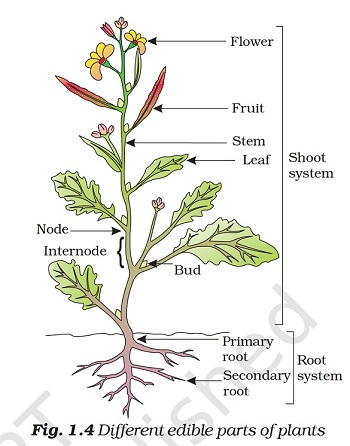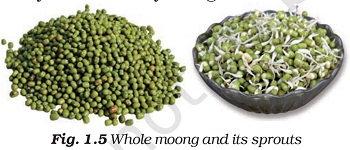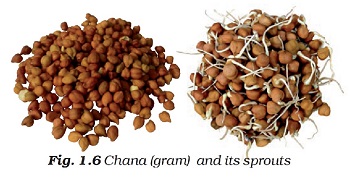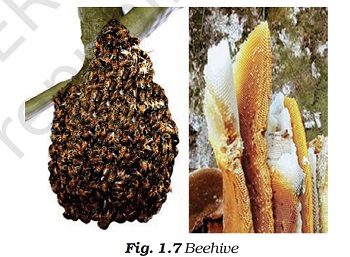1.3 PLANT PARTS AND ANIMAL PRODUCTS AS FOOD
NCERT class 6 science textbook for visually impaired students made accessible by Anubhav Patel, a student at Indian Institute of Information Technology, New Delhi, and Professor T K Bansal .
Plants are one source of our food. Which parts of a plant?
We eat many leafy vegetables. We eat fruits of some plants. Sometimes roots, sometimes stems and even flowers (Fig 1.4).

Have you ever eaten pumpkin flowers dipped in rice paste and fried? Try it!
Some plants have two or more edible (eatable) parts. Seeds of mustard plants give us oil and the leaves are used as a vegetable. Can you think of the different parts of a banana plant that are used as food? Think of more examples where two or more parts of a single plant are used as food.
Table 1.4 Plant parts as food
| Food item with plant as the major source | Ingredients/source | Plant part which gives us the ingredient |
|---|---|---|
| 1. Brinjal curry | Brinjal | Fruit |
| 1. Brinjal curry | Chilli as spice (any other) | Fruit |
| 1. Brinjal curry | Oil from groundnut, mustard, soybean, any other plant | Seed |
| 2. -- | -- | -- |
| 3. --- | --- | --- |
Note: Do not try to taste unknown plants around you to see if they are edible! Some plants could be poisonous.
Activity 4
From all the food items you have listed in Table 1.3, choose those items whose ingredients are obtained from plants. Which part of a plant? Identify these and list the food items and plant parts as shown in Table 1.4.
Activity 5
Take some dry seeds of moong or chana. Put a small quantity of these seeds in a container filled with water and leave this container aside for a day. Next day, drain the water completely and leave the seeds in the container. Wrap them with a piece of wet cloth and set aside. The following day, do you observe any changes in the seeds?
A small white structure may have grown out of the seeds. If so, the seeds have sprouted (Fig. 1.5 and 1.6). If not, wash the seeds in water, drain the water and leave them aside for another day, covered with a wet cloth. The next day, see if the seeds have sprouted.
Fig. 1.5 Whole moong and its sprouts

Fig. 1.6 Chana (gram) and its sprouts

After washing these sprouted seeds, you can eat them. They can also be boiled. Add some spices and get a tasty snack to eat.
Do you know where honey comes from? or how it is produced? Have you seen a beehive where so many bees keep buzzing about? Bees collect nectar (sweet juices) from flowers, convert it into honey and store it in their hive (Fig. 1.7).
Fig. 1.7 Beehive

Flowers and their nectar may be available only for a part of the year. So, bees store this nectar for their use all through the year. When we find such a beehive, we collect the food stored by the bees as honey.
